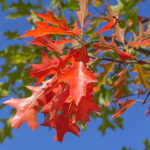You can’t guarantee fall color

Various parts of the country are known for their vibrant displays of fall foliage colors, none more so than the Midwest, and in particular, Michigan. It seems odd that we get such joy from the annual death of leaves from deciduous trees, shrubs, and even some perennials. Why do leaves change colors in the fall, and why can’t we guarantee that fall color to our customers?
I'm going to super-simplify the scientific part of this explanation so here goes:
- Chlorophyll produces carbohydrates (sugars) plants need for growth and is responsible for the green color in leaves and stems.
- Carotenoids express as yellow and orange and are generated during the growing season alongside the green.
- Anthocyanins are only produced in the fall after sugars are trapped in the leaves, and create reds and purples. More reds, and earlier reds, can come from plant stresses, low nutrition, and near-but-not freezing temperatures. Freezing stops the process of making red pigments.
During spring and summer chlorophyll masks the other pigments so you pretty much just see green, however shorter days, longer nights, and cooler temperatures trigger an abscission layer to form, cutting off the flow of sugars and replacement chlorophyll. As the green color fades, the underlying yellow and orange colors are revealed, and reds and purples develop. Eventually all the colors break down, leaving brown tannins.
What colors are produced, and in what amounts, and when in relation to other plants, is due to the genetics of a particular plant, growing conditions, and weather.
Similar environmental conditions as those causing red color in leaves also may cause fall colors to come sooner, or later, or to last longer some years than others. Drought during spring and early summer may signal the plant to form the abscission layer early, shutting down growth and causing color change sooner than usual.
So while moisture is good earlier in the season, too much late in the season means more clouds, less sun, and more muted colors. Too much rain in fall plus strong winds, may cause many leaves to fall prematurely. Cooler temperatures in late summer, and plenty of sunshine, often leads to brighter colors sooner. Cool is good, but too cold (freezing) can be bad, killing leaves early.
So ideal for fall color would be a moist growing season early, dry late summer and early fall, with sunny warm days and cool nights during the latter.
Choosing cultivars with known fall color-producing ability will certainly help, but as you can see there are other factors that come into play, and you really cannot guarantee fall color.




